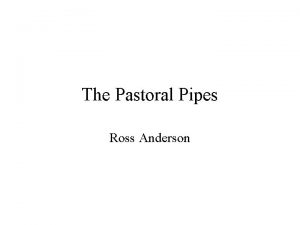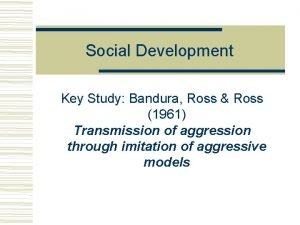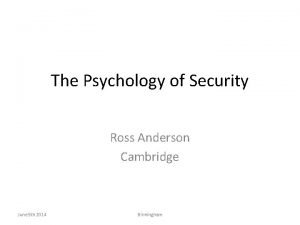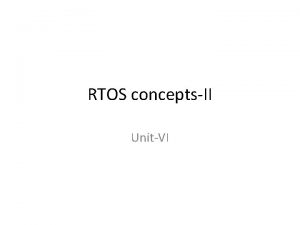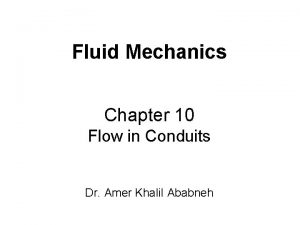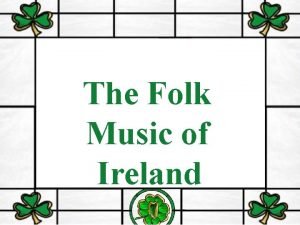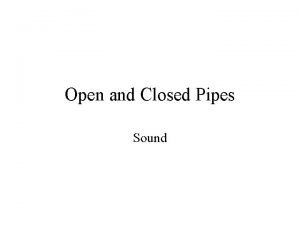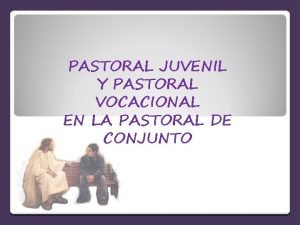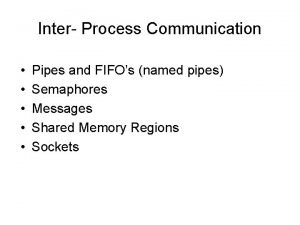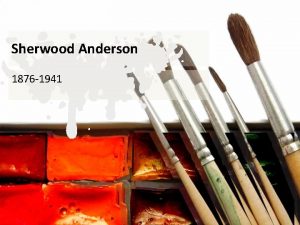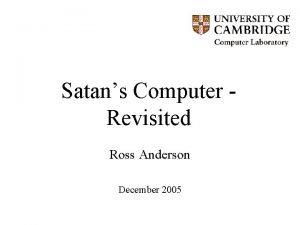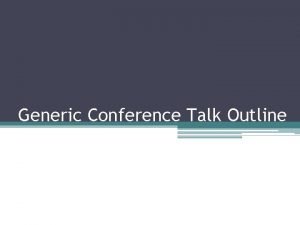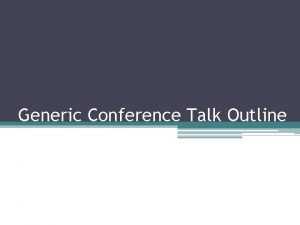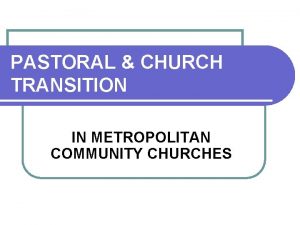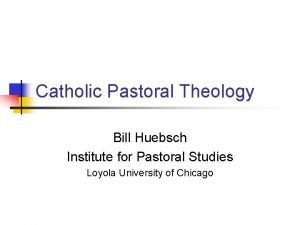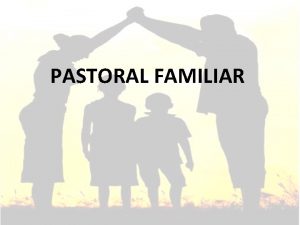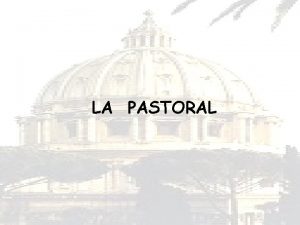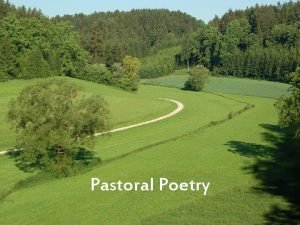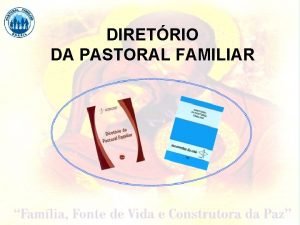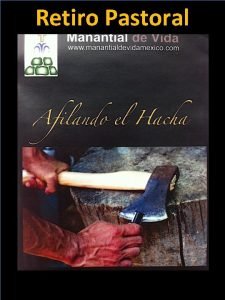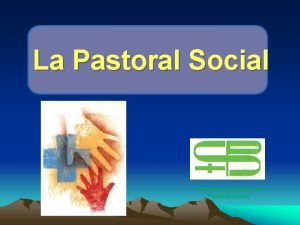The Pastoral Pipes Ross Anderson Outline of Talk




































- Slides: 36

The Pastoral Pipes Ross Anderson

Outline of Talk • • The written sources The instruments Getting a period instrument playing again Geoghegan Tuning What this teaches about 18 th century music What we still don’t know

Earliest Days • Many European countries have pipes that play an octave plus a few notes (gaita, cornemuse, …) • Pipes were based on shawms, and the typical shawm plays a few second-octave notes depending on the reed and the player • By the second quarter of the 18 th century, we find evidence of a more developed chanter • Maybe someone put an oboe into a set of border pipes, or based a chanter on an oboe

Border Pipes • ‘Old Geordy’ Sime, Dalkeith town piper and retainer to the Duke of Buccleugh • Painting by John Kay, about 1789 • Contemporary of travelling piper Jamie Allan

Oboe, Grand Bourbonnais, Pastoral Chanters, Union Chanter

Beggar’s Opera, 1728

The Written Sources • ‘The Compleat Tutor for the Pastoral or New Bagpipe’, John Geoghegan, 1743 • First book of bagpipe music published • Describes an instrument with an open end and range from low C to third-octave D, A drones • Text describes both Scots and Irish piping gracings • Repertoire: a mixture of traditional Scots/Irish tunes, popular airs, and pieces for the oboe






Objections to Geoghegan • There’s certainly some interesting material (e. g. “A Bagpipe Concerto call’d the Battle of Aughrim, or the Football March”) • But also tunes in keys like F and B flat – surely these don’t work well with A drones? • One tune has a low C sharp! • Consensus up till now: Geoghegan overstated his expertise

Advocates’ Manuscript • Found in National Library of Scotland • Classed as union pipe music, but several tunes have low C • I got permission to scan it and put it online (see www. piob. info) • Mostly Scottish dance tunes; some Irish • Wrote ‘The pastoral pipe repertoire, rediscovered’, Common Stock v 20 no 2 (Dec 2005)

The Sutherland Manuscript • In the Mitchell Library in Glasgow • Hundreds of tunes – mostly Scots, many Irish, also variation sets and popular airs • Only three ‘pastoral’ tunes with low C – the rest are playable on modern uilleann pipes • There’s also a fingering chart for the highland pipes showing two second-octave notes! • See ‘The Sutherland Manuscript’, An Piobaire, 2006

Later Sources • O’Farrell's Collection of National Irish Music for the Union Pipes, 1804 • O’Farrell taught music in London and played on stage – ‘Oscar and Malvina’ was a hit in 1791

Later Sources (2) • O’Farrell's Pocket Companion for the Irish or Union Pipes, 4 volumes 1805 -10 • The Mac. Kie Manuscript, 1828 • The Millar Manuscript, 1830 • Colclough’s Tutor, 1840

Late Pastoral Pipes • The Mac. Kie set of pastoral pipes, 1828 • National Museum of Scotland • Came with manuscript of music, now online at www. piob. info

Iconographic & other sources … • ‘The Dance of the Little People’, William Holmes Sullivan (early 19 th century) • Other references to ‘the long chanter’ up till about WW 1 • Sam Grier

The Instruments • Pastoral and early union pipes are found in many collections – notably the National Museum of Scotland the Chantry at Morpeth • See Hugh Cheape, ‘Bagpipes’, NMS, 2008 • Replicas have been made by Brian Mc. Candless, Sean Folsom, Michael Mc. Harg, Chris Bayley, Jon Swayne • I have two sets that were sold and Sotheby’s in 1994, then owned by John Hughes and Ken Mc. Leod

Getting an old instrument playing • Ken Mc. Leod fitted a new bag • Bass drone reed borrowed from another old set • The big problem with old pastoral chanters was always thought to be the chanter reed – the C, E always out of tune • Breakthrough at WKPF 2007 – I got a few narrowbore D reeds from Joe Kennedy and also played two chanters owned by Hamish Moore • All four chanters played the same!

The Late 18 C Pastoral Scale • Open – with the foot joint – the chanter plays like a highland chanter (but LH notes slightly flat unless some RH fingers raised) • Closed it plays like a union pipe except that C nat is x oxo xxxx and C# is o xxxx • So you can play either Irish or Scots style! • The cost is that the open second octave has some out-of-tune notes (notably E!)

The Key Insight • The reason people have struggled to reed pastoral chanters is not that making the reed is an impossible lost art… • It’s just that the scale is fingered differently! • I visited Jon Swayne and we played all combinations of our reeds and chanters • It turned out that when he’d copied my chanter, he’d moved the first finger hole up 3 mm to make the open C#, as on a modern chanter • Looking at old fingering charts, this is obvious!




Voicing for an Open Scale • Jon Swayne’s copy of my set, with the first finger hole 3 mm up the chanter, is also voiced to give a more in-tune E with the foot joint on • It plays well open across two octaves • Performance closed is OK but lacks bite, the low C tends to autocran, and it’s easy to get into the wrong octave (the reed is much softer than mine) • But it seems an appropriate instrument to play the Sutherland repertoire

Chanter Evolution? • • • 1700: border pipe: octave plus a few notes 1740: baroque oboe, in-tune played open 1760: people start playing staccato 1780: chanters being optimised for this 1800: recognisably modern chanters 1820: foot joints stop being made

Unexpected Research Holdup…

Later Chanter Evolution • The earliest chanter with modern fingering is the James Kenna set donated by Ken Mc. Leod and played by Ronan Browne • Even so, this has some slightly odd crossfingerings (as do sets until the 1840 s) • See for example fingering charts from O’Farrell, 1804 – he has a cross-fingered second octave C nat, and some notes must be played open • Fully modern fingering – 1815?



Implications for Music • First, we can rehabilitate John Geoghegan! • Pastoral chanters have small finger holes and so cross-finger well, like a recorder • No problem playing in F, G minor … • Geoghegan’s set had A drones (as did a set in Newcastle in early 20 C) which probably could tune to B flat • The low C sharp was the bell note with foot joint off for the oboe – and for Sean Folsom’s repro set

Implications for Music (2) • Older tunes tend to use C nat – e. g. listen to Kitty’s Rambles by Leo Rowsome • Even although C# is playable, it’s simpler to play the natural scale in fast dance music • Big source of ‘pastoral’ tunes is the Goodman manuscript – tunes from West Ireland in 1860 s • Johnny Doran’s music also has pastoral flavour • Older instruments likely to remain in use longer in more remote and marginalised communities

Next steps • Let’s get more 18 th century sets going • Even if museum sets can’t be refurbished their chanters can still be played • Then look again at manuscript sources once we understand chanter evolution timelines • Precedent: the early music movement – ‘historically inspired performance’

Conclusion • The pastoral pipe is the missing link in the evolution from the 17 th century border pipe / gaita / cornemuse design to the 19 th century union pipe • It wasn’t one single design, but a progression • The music also evolved through the 18 th century • Instruments stayed able to play ‘highland’ too • Their footprints in modern Scots and Irish music are evident once we know what to look for • And it’s time to rehabilitate John Geoghegan!
 Pastoral pipes
Pastoral pipes Aggressive role
Aggressive role Ross anderson cambridge
Ross anderson cambridge Talk read talk write
Talk read talk write Amateurs discuss tactics professionals discuss logistics
Amateurs discuss tactics professionals discuss logistics The words use are not
The words use are not Rtos mailbox
Rtos mailbox Lee pipes
Lee pipes Lee pipes
Lee pipes Heat pipes for electronics cooling applications
Heat pipes for electronics cooling applications Pvc pan flute measurements
Pvc pan flute measurements A must be established prior to masonry wall construction
A must be established prior to masonry wall construction Synerzip
Synerzip Plastic pipes uae
Plastic pipes uae How to calculate total head loss
How to calculate total head loss Offshore pipes
Offshore pipes Uilleann pipes
Uilleann pipes Palm pipes
Palm pipes Ence360
Ence360 Ben has had problems with the pipes in his apartment
Ben has had problems with the pipes in his apartment Open pipe instruments
Open pipe instruments Citation sandwich example
Citation sandwich example Công thức tính độ biến thiên đông lượng
Công thức tính độ biến thiên đông lượng Môn thể thao bắt đầu bằng từ chạy
Môn thể thao bắt đầu bằng từ chạy Thế nào là mạng điện lắp đặt kiểu nổi
Thế nào là mạng điện lắp đặt kiểu nổi Hát kết hợp bộ gõ cơ thể
Hát kết hợp bộ gõ cơ thể Dot
Dot Vẽ hình chiếu đứng bằng cạnh của vật thể
Vẽ hình chiếu đứng bằng cạnh của vật thể Nguyên nhân của sự mỏi cơ sinh 8
Nguyên nhân của sự mỏi cơ sinh 8 độ dài liên kết
độ dài liên kết Gấu đi như thế nào
Gấu đi như thế nào Thiếu nhi thế giới liên hoan
Thiếu nhi thế giới liên hoan Khi nào hổ con có thể sống độc lập
Khi nào hổ con có thể sống độc lập điện thế nghỉ
điện thế nghỉ Một số thể thơ truyền thống
Một số thể thơ truyền thống Trời xanh đây là của chúng ta thể thơ
Trời xanh đây là của chúng ta thể thơ Frameset trong html5
Frameset trong html5
